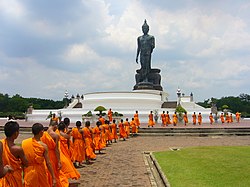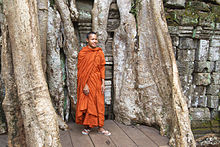This is an old revision of this page, as edited by Maytichai (talk | contribs) at 16:23, 6 April 2015. The present address (URL) is a permanent link to this revision, which may differ significantly from the current revision.
Revision as of 16:23, 6 April 2015 by Maytichai (talk | contribs)(diff) ← Previous revision | Latest revision (diff) | Newer revision → (diff) For other uses, see Bhiksu.| Bhikkhu | |||||||||
|---|---|---|---|---|---|---|---|---|---|
 Buddhist monks in Thailand Buddhist monks in Thailand | |||||||||
| Chinese name | |||||||||
| Chinese | 比丘 | ||||||||
| |||||||||
| Native Chinese name | |||||||||
| Chinese | 和尚 | ||||||||
| |||||||||
| Burmese name | |||||||||
| Burmese | ဘိက္ခု | ||||||||
| Tibetan name | |||||||||
| Tibetan | དགེ་སློང་ | ||||||||
| |||||||||
| Thai name | |||||||||
| Thai | ภิกษุ | ||||||||
| RTGS | phiksu | ||||||||
| Japanese name | |||||||||
| Kanji | 和尚 | ||||||||
| |||||||||
| Tamil name | |||||||||
| Tamil | Error: {{Lang}}: text has italic markup (help) | ||||||||
| Sanskrit name | |||||||||
| Sanskrit | भिक्षु | ||||||||
| Pali name | |||||||||
| Pali | Bhikkhu | ||||||||
| Nepali name | |||||||||
| Nepali | भिक्षु | ||||||||
A bhikkhu (Pāli, Template:Lang-sa bhikṣu) is an ordained Buddhist monk. A female monastic (a nun) is called a bhikkhuni (Template:Lang-sa bhikṣuṇī).
The lives of bhikkhus and bhikkhunis are governed by a set of rules called the prātimokṣa or pātimokkha. Their lifestyle is shaped to support their spiritual practice: to live a simple and meditative life and attain nirvana.
A person under the age of 20 cannot be ordained as a bhikkhu or bhikkhuni but can be ordained as a śrāmaṇera (สามเณร) or śrāmaṇērī.

Definition
Bhikkhu literally means "beggar" or "one who lives by alms". The historical Buddha, Prince Siddhartha, having abandoned a life of pleasure and status, lived as an alms mendicant as part of his renunciate lifestyle. Those of his more serious students who abandoned their lives as householders and came to study full-time under his supervision also adopted this lifestyle. These full-time students became the community of ordained monks and nuns (the sangha) who wandered from town to city throughout the year, stopping in one place only for the rainy months of the monsoon season (the vassa). Living by alms encourages the growth of spiritual attributes such as humility and brings direct awareness of the mutual interdependence of human beings.
In the Dhammapada commentary of Buddhaghosa a Bhikkhu is defined as "the person who sees danger (in samsara or cycle of rebirth)" (Pāli: Bhayaṃ ikkhatīti: bhikkhu). He therefore seeks ordination to obtain release from it. The Dhammapada states:
He is not a monk just because he lives on others' alms. Not by adopting outward form does one become a true monk. Whoever here (in the Dispensation) lives a holy life, transcending both merit and demerit, and walks with understanding in this world — he is truly called a monk.
In English literature before the mid-20th century, Buddhist monks were often referred to by the term bonze, particularly when describing monks from East Asia and French Indochina. This term is derived via Portuguese and French from the Japanese word bonsō for a priest or monk and has become less common in modern literature.
For historical reasons, the full ordination for women has been unavailable to Theravada and Tibetan Buddhist practitioners, although recently the full bhikṣuṇī status has been reintroduced to many areas.
Ordination
Theravada

Theravada monasticism is organized around the guidelines found within a division of the Pali Canon called the Vinaya Pitaka. Laypeople undergo ordination as a novice (Pali: samanera) in a rite known as 'the going forth' (Pali: pabbajja). Samanera are subject to ten precepts. From there full ordination (Pali: upasampada) as a bhikkhu or bhikkhuni may take place. From then on monks and nuns are subject to a much longer set of rules known as the Patimokkha (Theravada) or Pratimoksha (Mahayana schools).
Mahayana
In the Mahayana monasticism is part of the system of "vows of individual liberation". These vows are taken by monks and nuns from the ordinary sangha, in order to develop personal ethical discipline. In Mahayana and Vajrayana Buddhism, the term "sangha" is, in principle, often understood to refer particularly to the aryasangha (Tib. mchog kyi tshogs), the "community of the noble ones who have reached the first bhūmi". These, however, need not be monks and nuns.
The vows of individual liberation are taken in four steps. A lay person may take the five Upāsaka and Upāsikā vows (Tibetan dge snyan, dge snyan ma "approaching virtue"). The next step is to enter the pabbajja or monastic way of life (Srt: pravrajya, Tib. rab byung pronounced rabjung), which includes wearing monk's or nun's robes. After that, one can become a samanera or samaneri "novice" (Skt. śrāmaṇera, śrāmaṇeri, Tib. dge tshul, dge tshul ma). The last and final step is to take all the vows of a bhikkhu or bhukkhuni "fully ordained monastic" (Sanskrit: bhikṣu, bhikṣuṇī, Tib. dge long, dge long ma).
Monastics take their vows for life but can renounce them and return to non-monastic life and even take the vows again later. A person can take them up to three times or seven times in one life, depending on the particular practices of each school of discipline; after that, the sangha should not accept them again. In this way, Buddhism keeps the vows "clean". It is possible to keep them or to leave this lifestyle, but it is considered extremely negative to break these vows.
In Tibet, the upāsaka, pravrajya and bhikṣu ordinations are usually taken at ages six, fourteen and twenty-one or older, respectively.
Robes
Main article: Kasaya (clothing)

The special dress of ordained people, the robes, comes from the idea of wearing cheap clothes just to protect the body from weather and climate. Monks often make their own robes from cloth that is donated to them. They shall not be made from one piece of cloth, but mended together from several pieces. Since dark red was the cheapest color in Kashmir, Tibetan tradition has red robes. In the south, yellow played the same role, though the color of saffron also had cultural associations in India; in East Asia, robe color varies from yellow to brown (Thailand), red to purple (Burma) and grey or black (Vietnam).
The robes of Tibetan novices and monks differ in various aspects, especially in the application of "holes" in the dress of monks. Some monks tear their robes into pieces and then mend these pieces together again. Upasakas cannot wear the "chö-göö", a yellow tissue worn during teachings by both novices and full monks.
In observance of the Kathina Puja, a special Kathina robe is made in 24 hours from donations by lay supporters of a temple. The robe is donated to the temple or monastery, and the resident monks then select from their own number a single monk to receive this special robe.
Additional vows in the Mahayana and Vajrayana traditions
In Mahayana traditions, a Bhikṣu may take additional vows not related to ordination, including the Bodhisattva vows, samaya vows, and others, which are also open to laypersons in most instances.
Conclusion
"Ordination" in Buddhism is a cluster of methods of self-discipline according to the needs, possibilities and capabilities of individuals. According to the spiritual development of his followers, the Buddha gave different levels of vows. The most advanced method is the state of a bikshu(ni), a fully ordained follower of the Buddha's teachings. The goal of the bhikku(ni) in all traditions is to achieve liberation from suffering.
Talapoy
Buddhist monks were once called "Talapoy," from Portuguese talapão from Mon tala poi our lord.
Monks in Japan
Saicho (also known as Dengyo) petitioned for a Mahayana Ordination Platform to be built in Japan. Permission was granted seven days after Dengyo died. The platform was completed in 827 CE by Dengyo's disciple, Gishin. Dengyo believed the 250 precepts were Hinayana, and that people should be ordained with the Mahayana Precepts of the Brahma Net Sutra. He stipulated that monastics remain on Mt. Hiei for 12 years of isolated training and follow the major themes of the 250 precepts- celibacy, non-harming, no intoxicants, vegetarian eating and reducing labor for gain. After 12 years monastics would them the Sravaka Vinaya precepts as a provisional, or supplemental, guideline to conduct themselves by when serving in non-monastic communities.
During the Meiji Restoration, monastics in Japan were permitted through government pressure to marry and eat meat in an effort to secularise them and promote the new imperial Shinto as a state religion, Buddhists having been the administrative assistant of choice of the previous regime.
Currently, priests (lay religious leaders) in Japan choose to observe vows as appropriate to their family situation. Celibacy and other forms of abstaining are generally "at will" for varying periods of time.
Less often some people may choose a renunciate route (monks and nuns) and take personal vows of lifelong celibacy, vegetarian eating and voluntary simplicity. Following major themes of the personal-liberation discipline (Vinaya). In most sects strict living and discipline is followed during training periods and aspects of seminary but afterwards there is a considerable amount of individual approaches to religious lifestyle with much room for different opinions.
Gallery
-
 Young Indian Buddhist monk in India.
Young Indian Buddhist monk in India.
-
 A Theravada Buddhist monk in Laos
A Theravada Buddhist monk in Laos
-
 A Buddhist monk in China
A Buddhist monk in China
-
A Buddhist monk in Taiwan
-
 A Buddhist monk in the U.S. (Chinese Buddhism)
A Buddhist monk in the U.S. (Chinese Buddhism)
-
 A Buddhist monk in Tibet
A Buddhist monk in Tibet
-
Monks in Luang Prabang
-
 Monks in Thailand
Monks in Thailand
See also
| People of the Pāli Canon | ||||||||||||||||||||||||||||||||
|---|---|---|---|---|---|---|---|---|---|---|---|---|---|---|---|---|---|---|---|---|---|---|---|---|---|---|---|---|---|---|---|---|
|
||||||||||||||||||||||||||||||||
References
- ^ Ly Guide to the Monks' Rules
- What is a bhikkhu?
- Buddhist Dictionary, Manual of Buddhist Terms and Doctrines by Nyanatiloka Mahathera.
- ^ Resources: Monastic Vows
- Buddharakkhita, Acharya. "Dhammapada XIX — Dhammatthavagga: The Just". Access To Insight. Retrieved 18 December 2012.
- Dictionary.com: bonze
- ^ how to become a monk?
- 05-05《律制生活》p. 0064
- Buddhist Ceremonies and Rituals of Sri Lanka, A.G.S. Kariyawasam
- "talapoin". Collins Concise English Dictionary © HarperCollins Publishers. WordReference.com. June 23, 2013. Retrieved June 23, 2013.
Etymology: 16th Century: from French, literally: Buddhist monk, from Portuguese talapão, from Mon tala pōi our lord ...
- Roberts, Edmund (Digitized October 12, 2007) . "Chapter XIX. Talapoys or Priests". Embassy to the Eastern courts of Cochin-China, Siam, and Muscat : in the U. S. sloop-of-war Peacock ... during the years 1832-3-4. Harper & brothers. Page 297, image 304. OCLC 12212199. Retrieved 25 April 2012.
The Talapoys cannot be engaged in any of the temporal concerns of life; they must not trade or do any kind of manual labour, for the sake of a reward; they are not allowed to insult the earth by digging it. Having no tie, which unites their interests with those of the people, they are ready, at all times, with spiritual arms, to enforce obedience to the will of the sovereign.
{{cite book}}: Check date values in:|date=(help); Cite has empty unknown parameter:|nopp=(help) - ^ Soka Gakkai Dictionary of Buddhism, Soka Gakkai, 'Dengyo'
- http://www.bbc.co.uk/religion/religions/shinto/history/history_1.shtml#section_4
- http://www.buddhanet.net/nippon/nippon_partII.html
Further reading
- Inwood, Kristiaan. Bhikkhu, Disciple of the Buddha. Bangkok, Thailand: Thai Watana Panich, 1981. Revised edition. Bangkok: Orchid Press, 2005. ISBN 978-974-524-059-9.
External links
- The Buddhist Monk's Discipline Some Points Explained for Laypeople
- Thirty Years as a Western Buddhist Monk